A few weeks ago, I read Tracy Zager’s post about intuition. I also took the opportunity to go through her slides from her #CMC North presentation and push myself to think more deeply. In an effort to understand the role of intuition in math thinking, I recorded my entire thinking process – all of my mistakes, questions, and partial understandings in this post. I kind of feel like I am about to expose myself. I am making myself publicly vulnerable. This is not easy for me, but I am doing it in the interest of becoming a better math teacher and coach. Tracy has got me thinking that my job is to help students and teachers refine their math intuition. Therefore, I have to explore my own. Here are my candid thoughts. The picture on the left is a screenshot from Tracy’s slideshow (which can be found on her blog. Screenshots of my actual thoughts are on the right.




At this point in the exercise, things got really interesting. I started to wonder: I followed my intuition both times. When I listened to it, it helped me. Why did I get a closer estimate on the smaller pumpkin?
I followed my intuition both times. When I listened to it, it helped me. Why did I get a closer estimate on the smaller pumpkin?
Was it because I have more experience carrying objects that are closer to 5 pounds? Does it have to do with my question about weight distribution? Is it because heavy objects all feel so “heavy” – there is less clarification for me about “how heavy”?
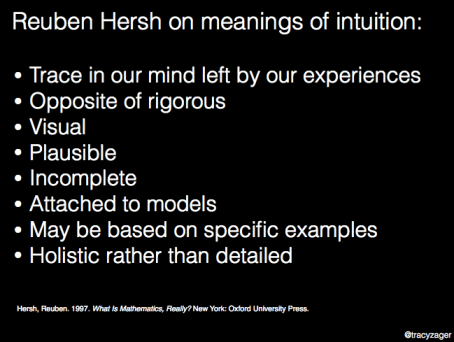
Reuben Hersh says intuition is a “trace in our mind left by our experiences”. Was I less intuitive about my larger pumpkin guess because I have less experience with carrying things that are over 5 pounds? Would a professional delivery person have had better intuition?
I think it is about those little voices, Tracy. Most of my childhood schooling was spent listening to the voices of my teachers. I didn’t spend any time developing my intuition. I think I started listening to those little math voices when I first started teaching. I was in a one room school house ten miles off the coast of Maine. I was the new teacher and my students were in Kindergarten, third grade, and sixth grade. I had no idea what I was doing. I will forever be indebted to Thom Buescher, a G/T consultant from Camden who was hired to help me figure out how to teach such a broad spectrum of learners. He suggested that the school board purchase the K-5 math program, Investigations in Number, Data, and Space and the 6-8 math program, Connected Math. So, they did. And I started opening up the communication lines with those little math voices who I hadn’t heard from in a very long time. I took those resources home and I did math, math and more math. I loved it. I learned so much math the 6 years that I taught on Monhegan, but I only scratched the surface. I left Monhegan in 2007. Since then, the amount of math voices in my head has grown exponentially.
However, I am finding, there are still a lot of communication lines with weak connections. Back to Tracy’s slideshow:


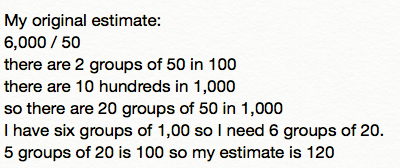



Now, I want to take a minute to remind you that you are looking at naked thinking. I am sharing screenshots of my thought process. You are seeing all the nuances of how I approached the problems in this slideshow. You are “seeing” me revise my thinking in my head. These notes have not been edited. While I took notes, I was intentionally trying to follow my own intuition and write down everything I thought, in an effort to see if I could find the communication “weak spots” in my own intuition. Watch what happens.


As I re-read these notes, I am fascinated. I have always been a “rusher”. I think too fast and it is not a surprise to me that I “saw” 4×4. I wonder how thinking fast impacts my intuition. As a student, I wasn’t given the time to hone my intuition. As an adult, I am realizing how important it is. The good news is – somewhere in my head- there is a “slow down voice”. Reread my notes above. Can you hear it? I think I would like to turn up the volume of that voice.
So, I continued to think about the other estimates on the slide.
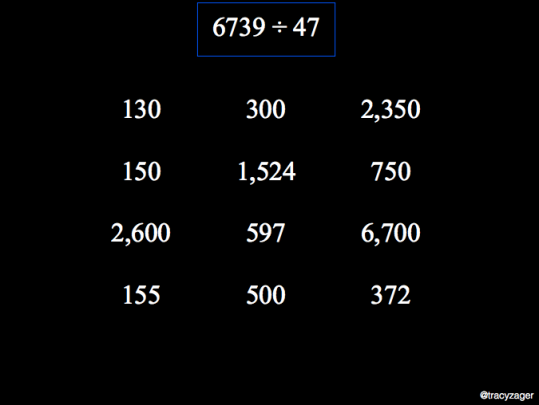
So my “gut” knows why 6,700 isn’t reasonable, but I am really struggling to find the precise words to explain it. Fascinating. When my intuition is strong, I struggle to explain it.
Try.
If I had 6,700 groups of 47, clearly I would have more than 6,739 because 6,700 x 47 is equivalent to 47 groups of 6,700 and 6,739 is barely over 1 group.
Ha!! Did you see that? I think I just refined my intuition by having to articulate it. What did I refine my intuition of? Perhaps the relationship between multiplication and division? Maybe the magnitude of numbers?
150 is unreasonable because 150 x 100 is 15,000. (150 x 10 is 1,500)
Wait a minute. I don’t want to just move up a place value – don’t rely on old tricks – refine your intuition, Sarah!
(15 x 10) x (10 x 10) = 15 x (10 x 10) x 10
15 x (100 x 10) = 15 x 1,000
15 x 1,000 = 15,000
Yes!
So if 150 x 100 = 15,000 than 150 is unreasonable because 150 x 50 = 7,500 because half of 100 is 50 so I need to cut 15,000 in half.
So it has to be less than 150 and greater than 120. Aha! So the most reasonable estimate on the slide is 130.
Ha! I just got to the part of the slides that talks about externalizing my thinking and I have been doing it the whole time.
Intuition is developed. Wow.
Tracy goes on to to say “My intuitions are based on my knowledge and my experience. The more I have, the more robust my intuitions are likely to be.” I am thinking it is really important to connect this with the earlier quote from Erich Wittmann:

So, as a learner, the key words are My. Me. I. If I want to hone my intuition, then the knowledge and experiences have to be mine, all mine. What does that mean? I think it means I have to make the mistakes, acknowledge the mistakes, articulate how I would correct the mistakes, and reflect on what I learned from the mistakes.
So is it just about mistakes?
No. I think it is also about connections. If I want to hone my intuition, I have to connect my experiences. I have to wonder how everything fits together. You can ask me questions to prompt me to wonder, but it has to be me who does the wondering and it has to be me who makes the discovery.
In their book, Making Number Talks Matter, Ruth Parker and Cathy Humphreys say some provocative things about whole group sharing. They say “Students are used to listening to their teachers’ explanations, and saying something once won’t hurt – as long as you don’t expect the students to understand just because you have explained it. They need to make sense of ideas for themselves.”
They also go on to say:
“Currently, deciding the order of sharing based on the sophistication of strategies, from least to most, is a popular notion. Using this method, it is argued, allows the underlying mathematical concept to build. We have valiantly tried this approach at one time or another but generally take a more organic approach….preselecting an order for sharing or scaffolding toward our “best explanation” can take the agency right out of the hands of students and make processing time almost algorithmic”
Wow. I recently posted this quote on Twitter because it really hit me in “the gut”. It spoke to me. It was one of those little voices. It connected a lot of other recent wonderings:
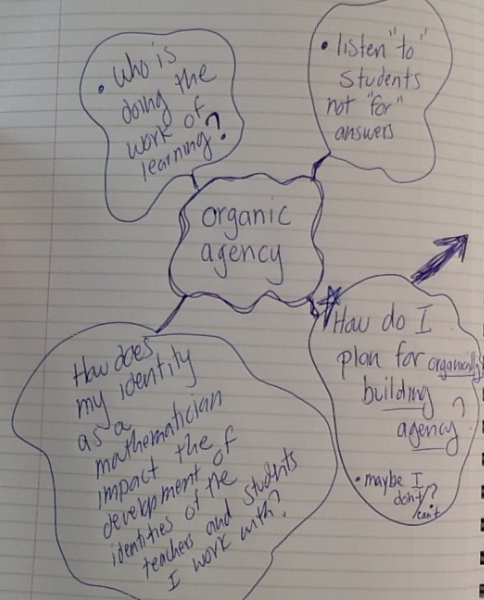
The Twitter post prompted a conversation about when and how to sequence student work. It prompted a great conversation about purpose and intention. As a facilitator, I wonder, is it possible to sequence work AND hone intuition? Is there a difference between organic sequencing and planned sequencing? Am I facilitating opportunities for students to connect ideas or am I sharing ways that I connect ideas? When I solve problems as I anticipate student thinking, am I taking the time to connect my ideas or am I just rattling off a bunch of different ways that students might use to solve the problem? Am I honing my own intuition or am I “planning my presentation”? Yikes. This is tough.
How do I balance honing and planning? Is there a connection between honing my intuition as a math learner and honing my intuition as a math teacher? Does the former inevitably impact the later?
In her slide show, Tracy prompted me to look through a series of questions that promote intuition, choose one from each category, and incorporate it into my teaching. My goal for 2017 is to take Tracy’s advice, but make a slight modification:
- I will incorporate the following questions into my teaching AND learning:
- Forget about the question for a second. What’s going on in this situation?
- Let’s refresh our memories about what each of these numbers represents.
- Slow down. We want to follow your thinking. Can you tell us your reasons for approaching it that way?
- How did thinking about your experience with __________ help you here?
- What tipped you off that something wasn’t right?
-
It feels counterintuitive, doesn’t it? Say more about that.
-
What’s making you doubt?
-
Did anyone change your mind today? How?
My favorite part of this goal is that I haven’t even read Tracy’s book, yet!! I am waiting for it to arrive in the mail. I am just finishing up Making Number Talks Matter. I am really looking forward to continuing my “gut checks”.









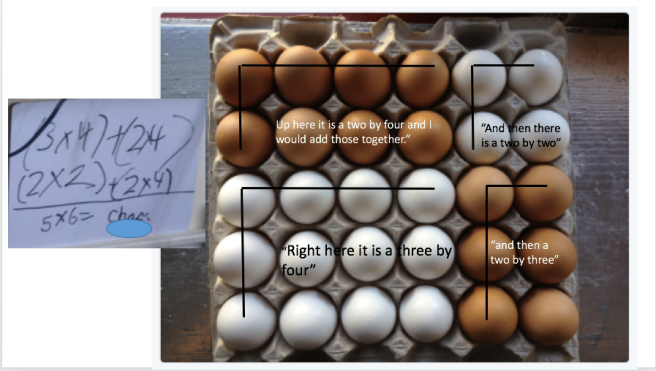




 At first, I thought, “how would any of those problems be easy to do in my head?” Then, I saw an entry point. I thought about multiplication as “groups” and I realized that I didn’t actually have to do a lot of complicated computing. I could combine the groups to make friendlier numbers. I thought of 23 x 37 – 13 x 37 as 23 groups of 37 minus 13 groups of 37. That is equal to 10 groups of 37 which is 370. All of a sudden, these problems seemed much more accessible. I was able to solve the others in a similar way, except one. I decided to reach out to @nomad_penguin, who originally posted the problems, to see if she could help me out.
At first, I thought, “how would any of those problems be easy to do in my head?” Then, I saw an entry point. I thought about multiplication as “groups” and I realized that I didn’t actually have to do a lot of complicated computing. I could combine the groups to make friendlier numbers. I thought of 23 x 37 – 13 x 37 as 23 groups of 37 minus 13 groups of 37. That is equal to 10 groups of 37 which is 370. All of a sudden, these problems seemed much more accessible. I was able to solve the others in a similar way, except one. I decided to reach out to @nomad_penguin, who originally posted the problems, to see if she could help me out.






